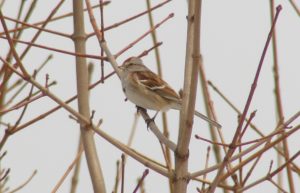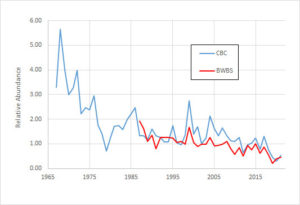(Photos and story by Pam Hunt)
Of the almost 300 species of birds that occur regularly in the Granite State, over 80 don’t breed here, and it’s time to take a break from our usual dose of nesting species to check in on one that’s only here in the winter. The American Tree Sparrow is sometimes called the “winter chippy” because it has a rusty cap like the Chipping Sparrows that nest throughout New Hampshire, and this similarity is sometimes a source of confusion. Chipping Sparrows are not expected in the state between November and April, and thus barely overlap with their larger relatives. Note also that Chipping Sparrows lack their reddish cap in the winter and have a very different face pattern. They have a buffy and dark brown stripes above and through their eyes, respectively, while those same areas in American Tree Sparrow are gray and rusty. The tree sparrow also has a dark spot on its breast and a yellow lower bill. The only time you really have a chance of seeing the two species together is in November, when lingering Chippings and early trees may join other sparrows in loose flocks in weedy fields and shrubby edges.


Although still abundant, American Tree Sparrows have declined by roughly 50% in the last 50 years. Because their ecology is little studied, we don’t have a good explanation for this at present. One hypothesis is that intensified agriculture in the Midwest and Great Plains (where the species reaches its highest winter densities) has eliminated much of the weedy and shrubby habitat needed by wintering birds. Development and forest maturation have probably had a similar effect here in the Northeast. There is also the possibility that climate change could be affecting their nesting habitat or breeding success.
Another interesting pattern shown in this graph is the somewhat synchronous ups and downs in the two data sets. Such variation is not uncommon in many of our wintering birds, and generally reflects variation in food availability. In years where there is more food farther north, fewer individuals migrate as far south, and the whole population shifts slightly in latitude. This is analogous to the periodic “irruptions” shown by winter finches such as crossbills and redpolls (and December’s “Bird of the Month,” the Purple Finch), with a key difference being that sparrows and juncos are always around rather than showing a boom/bust cycle.
To help us track New Hampshire’s winter bluebird populations, we encourage you to participate in the annual Backyard Winter Bird Survey each February.
State of the Birds at a Glance:
- Habitat: Shrublands and Developed
- Migration: Short-distance
- Population trend: Declining
- Threats: Cats; loss of shrublands, especially in agricultural landscapes; climate change
- Conservation actions: Keep cats indoors, maintain shrubs and weedy edges
NH Audubon’s “Backyard Winter Bird Survey” will occur on February 12-13, 2022. Visit https://www.nhaudubon.org/education/birds-and-birding/backyard-winter-bird-survey/ for details.
More information on “The State of New Hampshire’s Birds” is available at: https://www.nhaudubon.org/conservation/the-state-of-the-birds/
